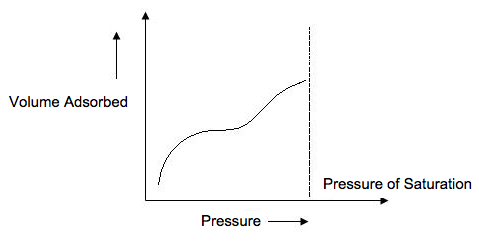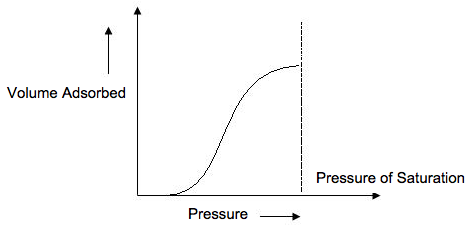| << Chapter < Page | Chapter >> Page > |

Type IV isotherms ( [link] ) occur when capillary condensation occurs. Gases condense in the tiny capillary pores of the solid at pressures below the saturation pressure of the gas. At the lower pressure regions, it shows the formation of a monolayer followed by a formation of multilayers. BET surface area characterization of mesoporous materials, which are materials with pore diameters between 2 - 50 nm, gives this type of isotherm.

Type V isotherms ( [link] ) are very similar to type IV isotherms and are not applicable to BET.

The BET equation, [link] , uses the information from the isotherm to determine the surface area of the sample, where X is the weight of nitrogen adsorbed at a given relative pressure (P/Po), X m is monolayer capacity, which is the volume of gas adsorbed at standard temperature and pressure (STP), and C is constant. STP is defined as 273 K and 1 atm.
Ideally five data points, with a minimum of three data points, in the P/P 0 range 0.025 to 0.30 should be used to successfully determine the surface area using the BET equation. At relative pressures higher than 0.5, there is the onset of capillary condensation, and at relative pressures that are too low, only monolayer formation is occurring. When the BET equation is plotted, the graph should be of linear with a positive slope. If such a graph is not obtained, then the BET method was insufficient in obtaining the surface area.
Single point BET can also be used by setting the intercept to 0 and ignoring the value of C. The data point at the relative pressure of 0.3 will match up the best with a multipoint BET. Single point BET can be used over the more accurate multipoint BET to determine the appropriate relative pressure range for multi-point BET.
Prior to any measurement the sample must be degassed to remove water and other contaminants before the surface area can be accurately measured. Samples are degassed in a vacuum at high temperatures. The highest temperature possible that will not damage the sample’s structure is usually chosen in order to shorten the degassing time. IUPAC recommends that samples be degassed for at least 16 hours to ensure that unwanted vapors and gases are removed from the surface of the sample. Generally, samples that can withstand higher temperatures without structural changes have smaller degassing times. A minimum of 0.5 g of sample is required for the BET to successfully determine the surface area.

Notification Switch
Would you like to follow the 'Physical methods in chemistry and nano science' conversation and receive update notifications?